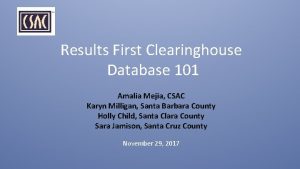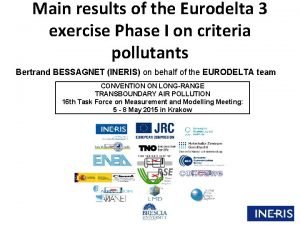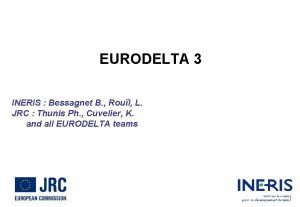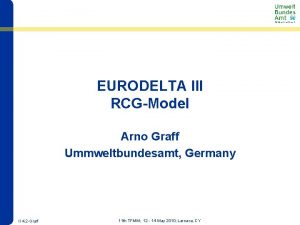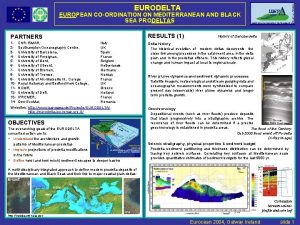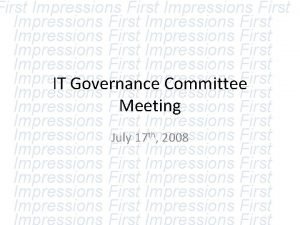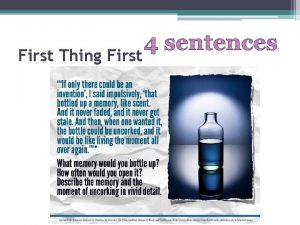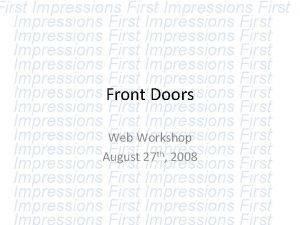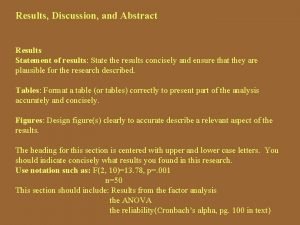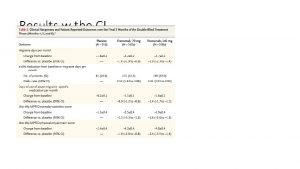Overview of the first results of the EURODELTA

















- Slides: 17

Overview of the first results of the EURODELTA 3 model intercomparison project Bertrand BESSAGNET (INERIS) on behalf of the EURODELTA team CONVENTION ON LONG-RANGE TRANSBOUNDARY AIR POLLUTION th 14 Task Force on Measurement and Modelling Meeting : Zagreb (Croatia), 6 -8 May 2013

The Eurodelta III exercize • Two phases: 1. Simulation of campaigns (2009, 2008, 2007, 2006) • validation 2. Retrospective analysis (2008, 1999, 1990) • Ability of models to reproduce the difference of concentrations for the three key years, how models work under different chemical regimes • Common inputs for models : meteorology (IFS), emissions (EC 4 MACS dataset), boundary conditions (MACC), domain (except CMAQ) • CAMx (PSI/RSE), CHIMERE (INERIS), CMAQ (HZG), EMEP (Met. no), LOTOS-EUROS (TNO), MINNI (ENEA), RCG (FUB) • Others participants: – DG JRC, CIEMAT, BSC, IPSL-CNRS, Univ of Brescia, NILU – TOTAL, CONCAWE, LWA

Status of the exercize Start of the exercize in April 2012 April June : work on input data June October : work on models November : production of runs December : first discussion on 2009 campaign January February : consolidation of observation datasets (some surprises in data: outliers , daily obs starts often at 8: 00) • April : discussion on last results • • June 2013 : preparation of a report on the 2009 campaign • End of 2013 : other campaigns + start of retrospective analysis

2009 campaign (25/02 – 26/03) • Available observations : hourly and daily obs background data (EMEP & campaigns : EBAS) • Comparisons on: – NO 2, O 3, SO 2, PM 10, PM 2. 5, HNO 3, NH 4, Dust, TOM, EC, Na – AMS data are compared with PM 2. 5 modelled results – TOM = 1. 6 x OC – Wet deposition S, N – PBL, T 2 M, U 10, RAIN

PM 10 average concentrations Ø Visible wind blown dust for EMEP Ø LOTO and CMAQ have the lowest PM 10 concentrations Ø Po Valley : different patterns for RCGC and LOTO Ø High concentrations for MINNI

Total nitrate average concentrations Ø CHIM has no coarse nitrate (too low in Spain) Ø MINNI and CMAQ have too high concentrations Ø Different pattern over the Po valley for LOTO and RCGC

Dust average concentrations Ø Dust as 8 x. Ca Ø EMEP, MINNI, RCGC and LOTO have wind blown dust emission modules Ø Ability of EMEP to reproduce a dust event in Cyprus

Sulphate average concentrations Ø CHIM has the highest concentrations (too high) Ø Similar gradient W/E for all models

Cumulated NHx wet deposition over the campaign

Diurnal cycles Ø O 3 : CMAQ, EMEP and CHIM have the lowest bias Ø NO 2 : LOTO has the lowest bias, best diurnal cycle for MINNI Ø PM 10: MINNI has the best diurnal cycle

Diurnal cycles Ø Na : CHIM & MINNI overshoot, best performances for RCGC, EMEP and LOTO Ø TOM : Underestimate by models Ø NO 3 : CHIM & EMEP have the best performances

Meteorology Ø Same meteorology but different way to calculate mixing and PBL Ø On average for the PBL at 12: 00 : • CHIM & CAMX have the lowest negative bias (-100 m) • MINNI : large negative bias ( -400 m) Near Paris

Best performances based on RMSE Model ranking based on daily basis data • • • O 3 NO 2 SO 2 PM 10 PM 25 SO 4* NH 4* NO 3* TOM* EC* DUST* NA* All daily obs. CHIM, CAMX, EMEP CAMX, CHIM, EMEP CHIM, LOTO, EMEP, CHIM, MINNI, EMEP, CMAQ, LOTO EMEP, LOTO, CHIM, EMEP, LOTO CHIM, MINNI, RCGC EMEP, MINNI, LOTO EMEP, LOTO, CAMX EMEP, LOTO, RCGC * ɸ < 10 µm 10% highest obs. CAMX, EMEP, CHIM EMEP, MINNI, LOTO EMEP, LOTO, CMAQ EMEP, MINNI, CHIM, CAMX MINNI, CAMX, CHIM, CMAQ, MINNI CHIM, MINNI, RCGC CAMX, CHIM, MINNI EMEP, MINNI, LOTO RCGC, MINNI, CAMX EMEP, RCGC, CHIM

« Deposition capability » in the models Indicator: (Deposition/Concentration) for dry deposition (Deposition/Concentration/Rain) for wet deposition ×

Chemical regime for SIA chemistry Free ammonia (mol) = TNH 4 – TNO 3 – 2 x SO 4

Identified problems and general comments Ø By model: – – – – CAMX : Problem (or not!) with SOA chemistry CHIM : Overestimate of sea salts and sulphates (Boundary conditions? ) CMAQ : Underestimates PM 10 concentrations MINNI : Underestimates the PBL EMEP : Low TOM concentrations LOTO : Low TOM and PM 10 concentrations RCGC : Noisy wind blown dust parameterization Ø In general : – underestimate of TOM concentrations, not specially during episodes (negative bias of 50 to 80%) : SVOC emissions ? – General underestimate of PM peaks (Dust events, TOM event in some countries CH, IT, ES). Wood burning emissions? – SIA are well modelled – Dust parameterizations remain uncertain but EMEP catches well the CY dust event – Still a large model variability (dispersion and mixing, chemistry, biogenic, deposition schemes, landuse)

Remaining todos for the 2009 campaign Ø Need to evaluate the MACC boundary conditions (MOZART : O 3, Dust, SO 4) Ø Ozone profiles will be tested Ø Focus on episodes on highly instrumented sites Ø Understand the differences between SOA models and check the emissions of precursors Ø Need to compare with BSOA, BBOA measurements if available Ø Diffusion of results : report, web site
 Results first clearinghouse
Results first clearinghouse Hát kết hợp bộ gõ cơ thể
Hát kết hợp bộ gõ cơ thể Frameset trong html5
Frameset trong html5 Bổ thể
Bổ thể Tỉ lệ cơ thể trẻ em
Tỉ lệ cơ thể trẻ em Gấu đi như thế nào
Gấu đi như thế nào Tư thế worm breton là gì
Tư thế worm breton là gì Chúa yêu trần thế
Chúa yêu trần thế Các môn thể thao bắt đầu bằng tiếng chạy
Các môn thể thao bắt đầu bằng tiếng chạy Thế nào là hệ số cao nhất
Thế nào là hệ số cao nhất Các châu lục và đại dương trên thế giới
Các châu lục và đại dương trên thế giới Công thức tiính động năng
Công thức tiính động năng Trời xanh đây là của chúng ta thể thơ
Trời xanh đây là của chúng ta thể thơ Mật thư tọa độ 5x5
Mật thư tọa độ 5x5 Làm thế nào để 102-1=99
Làm thế nào để 102-1=99 Phản ứng thế ankan
Phản ứng thế ankan Các châu lục và đại dương trên thế giới
Các châu lục và đại dương trên thế giới Thơ thất ngôn tứ tuyệt đường luật
Thơ thất ngôn tứ tuyệt đường luật
